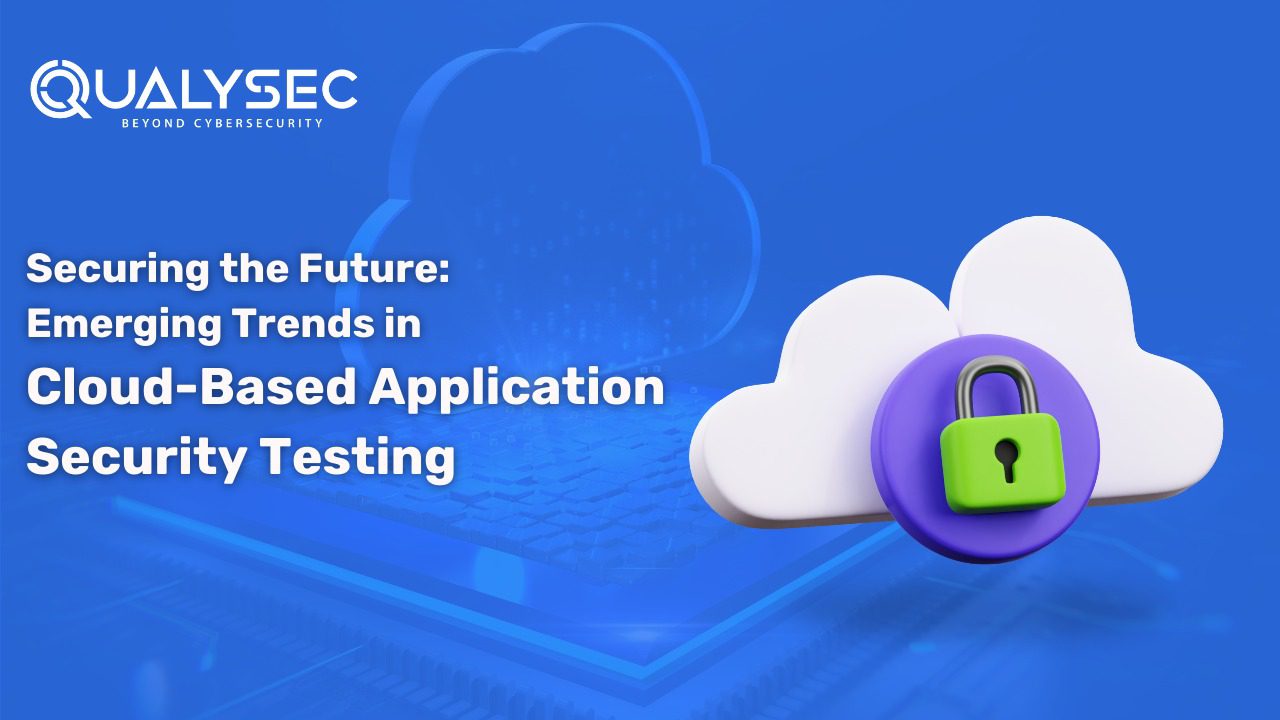© 2024 Qualysec.com Disclaimer Privacy Policy Terms & Conditions

Despite significant cybersecurity spending, 78% of senior IT and security professionals think their firms are not adequately prepared for a cyberattack, according to a new poll. Given that 50% or more of the enterprises surveyed in cloud-based application security testing report are concerned about cloud threats.
It’s no surprise that organizations are focusing on strengthening their cloud security posture going forward. Several main cloud security techniques are emerging as the most popular and successful during this process. We evaluated the top cloud security trends and gave insights on methods that may help you apply them to help you make an informed choice on how to improve your organization’s security posture.
Cloud security testing refers to the strategies, technologies, laws, and safeguards used to protect data, applications, and infrastructure hosted or managed inside cloud ecosystems. These cloud ecosystems include public clouds such as Amazon Web Services, Microsoft Azure, and Google Cloud.
The primary purpose of cloud security is to ensure the confidentiality, integrity, and availability of assets and data in cloud settings. It also seeks to reduce risks associated with potential security dangers and vulnerabilities. Furthermore, it detects security flaws in your cloud service before hackers do. Depending on the kind of cloud service and the provider, various manual approaches, cloud penetration testing methodologies, and cloud security testing tools may be utilized.
Read this to learn the purpose of penetration testing
Cloud security, like cloud computing, grew in tandem as enterprises sought to protect all assets in the cloud environment. During the COVID-19 pandemic, cloud security hit a new high due to a rapid surge in cloud use.
Within the first year of the pandemic, the cloud computing industry in the United States grew from $73.6 billion to $274.79 billion. Businesses began transitioning to the cloud since they could no longer rely entirely on local servers and in-house hardware, and these organizations needed to safeguard their cloud infrastructure and applications.
Furthermore, the explosive expansion of cloud-based application security testing has led to a phenomenal increase in cybercrime. As a result, cloud security became the first line of protection, allowing enterprises to operate their operations seamlessly. As cloud security progressed, new technologies were introduced, strengthening the foundation of cloud security.
Cloud pentesting requires some steps to be followed, such as:
Want to check what the pentest report looks like? Click here to download the sample report.
Read this comprehensive blog to learn precisely about Cloud-Based Penetration Testing
Understanding the hazards associated with cloud computing is a critical first step. The following are the top three security threats in cloud security:
1. DDoS
The most prevalent type of cloud assault is exceedingly devastating. Furthermore, DDoS (Distributed Denial of Service) is a type of attack that includes denying legitimate users access to internet services by flooding them with fraudulent connection requests.
How to Deal:
The loss of personal and sensitive information and data – both mistakenly and purposefully – is the most significant and crucial cloud computing hazard for enterprises today. Insider threats are another source of critical information leakage. Storing sensitive data and passwords in plain text files makes them vulnerable if attackers get access to them.
How to Deal:
It is the most serious threat to cloud security. Furthermore, according to a recent cloud security spotlight research, 53% of respondents consider unauthorized access via faulty access restrictions and employee credential abuse to be the most serious cloud security concern. Unauthorized access occurs when people get unauthorized access to company data, networks, endpoints, devices, or applications.
How to Deal:
If you want to learn more about cloud threats and security pentesting, there’s always an expert for you. Talk to our Expert Security Consultant for FREE to know more and get your cloud secured today!
What are the Benefits of Cloud Security Penetration Testing?
Cloud-based penetration testing is a critical security strategy for companies that use the public cloud. Here are some of the benefits of cloud security pentesting:
The identification of any vulnerabilities through cloud security testing services guarantees that they are quickly fixed. Even the most minor flaws can be detected by thorough scanners. This is critical since it aids in the prompt correction of the vulnerability before hackers exploit it.
Cloud penetration testing helps repair flaws in your cloud infrastructure, keeping your sensitive data safe and secure. This decreases the chance of a huge data breach, which may damage your company and its consumers, as well as have reputational and legal ramifications.
Regular cloud penetration testing reduces the likelihood of a security event, saving your company the cost of recovering from the assault. Much of the cloud penetration testing process may also be automated, allowing human testers to focus on higher-level operations while saving time and money.
Many data privacy and security laws impose severe controls or rules on enterprises. Furthermore, cloud-based penetration testing may reassure your company that it is taking necessary steps to improve and maintain the security of its IT systems and cloud environment.
Conducting frequent cloud pentests can assist in improving the dependability and trustworthiness of cloud providers. Because of the cloud provider’s security-conscious nature, this can bring in additional clients while keeping existing clients satisfied with the degree of protection offered for the data kept by them.
Today’s cloud service companies go to great lengths to make the data on their servers secure. This includes protocols that prevent data from one organization from entering the data of another. The user must still ensure the security of their passwords and connections, just as they would if the data was stored locally. Let’s take a look at the present procedures that are in place:
Every year, the environment of cyber assaults evolves, and there have been several important strikes in recent years. Furthermore, businesses will face several new cyber assaults in 2023, which is why we’ve compiled a list of the top cyber security trends to assist you in keeping ahead of growing threats. Here are the trends that your security teams should be aware of in 2023:
To infiltrate the cloud, hackers will look for weak links in supply chains and deliberately target firms with valuable data. This is why cyber security will create a cloud security testing methodology to prevent attackers from moving laterally by limiting the privileges and entitlements of each private and external identity, such as machine IDs that may access cloud resources. Supply chain assaults have been found to erode consumer loyalty and trust, resulting in a bad public view of many firms. Being prepared can help to limit harm to business operations, reputation, and financial losses.
In 2023, cloud-based enterprises will use the zero-trust approach, which states that organizations must verify everything before trusting anything within or outside the business’s perimeter. Because every enterprise is migrating to the cloud, it is critical to implement a zero-trust paradigm that allows only the appropriate users and services to access data and resources. Unlike traditional cloud penetration testing methodology, which is incapable of protecting resources, zero trust architecture contributes to a stronger security posture by lowering the attack surface and mitigating all risks.
APIs (Application Programming Interfaces) are becoming a vital component for linking different services as firms continue to embrace microservices designs. APIs, on the other hand, might be susceptible sites of attack if not adequately protected. Expect a greater emphasis on API security in 2023, including measures such as access limits, data encryption in transit, and extensive input validation to avoid injection attacks.
DevSecOps is a process for incorporating security policies throughout the Software Development Lifecycle (SDLC). Organizations would be able to take proactive action against threats rather than reacting reactively if security measures are implemented early in the process. DevSecOps is especially useful in the quick, fully automated development cycle that allows secure innovation. DevOps and Security teams must collaborate to establish robust security controls across the supply chain and to make security a continuous activity inside the Continuous Integration/Continuous Delivery pipeline.
Businesses will use AI and machine learning to detect and respond to assaults more quickly and accurately. Furthermore, the development of edge devices and the Internet of Things is driving the implementation of AI-based security solutions. To defend themselves, an increasing number of enterprises are turning to cloud-based security solutions that depend on biometric identity and machine intelligence. In addition, these technologies will get more cost-efficient, effective, and productive as time goes on.
Cloud security is a combined effort of many cybersecurity methods, procedures, and solutions. Here we’ve compiled the most effective ways to safeguard your cloud computing environment:
Some firms give workers significant access to systems and data at the same time to guarantee they can do their tasks efficiently. To avoid this, as part of the user power management process, your business can frequently review and remove user access capabilities. Consider the idea of least privilege, which asserts that users should only have access to data that is required to accomplish their work. In such a circumstance, hacking a user’s cloud account grants thieves only restricted access to sensitive data.
Keeping track of privileged users in your cloud infrastructure is one of the most important private cloud security best practices. System administrators and top management often have greater access to sensitive data than average users. As a result, whether purposefully or unwittingly, privileged users might inflict more damage to the cloud environment. When implementing your cloud architecture, it’s critical to check for default service accounts, which are usually in privilege.
Engage your cloud service provider to fully comprehend their shared responsibility model. To avoid gaps or overlaps in security duties, clarify them. Furthermore, define roles and responsibilities for cloud security testing inside your business. Create monitoring tools to guarantee that security standards are followed.
Companies should enable logging in their cloud services, and then take it a step further by feeding that data into a security information and event management (SIEM) system for centralized monitoring and response. Effective logging is particularly critical for coping with misconfigurations since it allows for the tracking of changes that might lead to vulnerabilities and the implementation of preventative measures. It also aids in the detection of persons with excessive access permissions, allowing modifications to decrease potential risks.
Because endpoints frequently connect directly to the cloud while using a cloud service, effective endpoint security increases. New cloud projects offer an opportunity to reevaluate security strategies and adapt to new risks. Implement a defense-in-depth strategy that comprises the following components:
Complex endpoint security issues need the use of automated security techniques. Patch management, endpoint encryption, VPNs, insider threat protection, and other measures are also a concern.
The next cloud-based application security testing environment has the potential to be a dynamic and disruptive sector. As technology advances, cloud security will confront a slew of new threats and possibilities. Furthermore, the rising complexity of cloud infrastructures emphasizes the importance of comprehensive security measures.
Zero Trust Architecture (ZTA) will become the de facto security paradigm, stressing continuous trust verification for users and devices. Furthermore, integrating security into the DevOps pipeline will speed up the secure deployment of apps.
As cloud technology advances, so will the techniques and technologies used to protect data and apps, ensuring that cloud security. Overall, security embed into the development and use of the software.
QualySec Technologies emerges as a beacon of excellence in the arena of fortifying cloud applications, seamlessly merging innovation, dependability, and efficiency while consistently maintaining cloud service penetration testing. We are well-known for our groundbreaking process-based VAPT penetration test and deliver bespoke security solutions that satisfy the most stringent industry standards.
Furthermore, we ensure that your apps are fortified against shifting threats by adopting a Hybrid security testing strategy (a combination of automation and manual pentest) and leveraging the expertise of a professional testing team. In-house and commercial cloud security testing tools such as CloudBrute and Nessus are used in our pentesting services.
We are persistent partners for enterprises seeking comprehensive security solutions while negotiating regulatory compliance requirements such as GDPR, SOC2, ISO 27001, and HIPAA. Furthermore, we commit to empowering developers.
Our in-depth, developer-friendly pentesting report provides a road map for fixing vulnerabilities. Furthermore, we equip you with the expertise you need to improve your application’s security posture, from locating the vulnerability to delivering step-by-step remedies.
QualySec takes pride to have a perfect zero-data-breach record, having protected over 250 apps and extended our knowledge to 20+ countries through a global network of 100+ partners. Contact QualySec today for a more secure future for your application and company by using unequaled knowledge.
The top cloud security trends show the current evolution of cybersecurity to meet rising security risks and solutions to protect all cloud resources. We have examined all of the security trends that you can use to reinforce your whole cloud infrastructure and improve your security posture in this guide.
You can keep ahead of bad actors and deal with the ever-changing world if you use the correct cloud-based pen testing tools and techniques. Furthermore, staying aware and adjusting to these trends will be critical for protecting sensitive data and ensuring the confidence of users.
What is a cloud penetration test?
Cloud penetration testing intends to examine a cloud system’s strengths and vulnerabilities to enhance its overall security posture. Cloud penetration testing services aid in the identification of risks, weaknesses, and gaps. Furthermore, the consequences of vulnerable vulnerabilities. Determine how to make use of any access gained through exploitation.
How do I start cloud pentesting?
There are 7 steps of cloud security penetration testing. Reconnaissance, scanning, vulnerability assessment, exploitation, reporting, retesting, and certification are the seven steps of penetration testing. All of these factors are critical in determining an organization’s security posture.
What is the difference between pentesting and cloud pentesting?
Both pentesting and cloud penetration testing strive to detect security flaws. The distinction is that cloud penetration testing focuses specifically on cloud-based systems and services, taking into consideration cloud-specific security problems and the shared responsibility paradigm.





Plot No:687, Near Basudev Wood Road,
Saheed Nagar, Odisha, India, 751007
No: 72, OJone India, Service Rd, LRDE Layout, Doddanekundi, India,560037
© 2024 Qualysec.com Disclaimer Privacy Policy Terms & Conditions


No: 72, OJone India, Service Rd, LRDE Layout, Doddanekundi, India,560037
© 2024 Qualysec.com Disclaimer Privacy Policy Terms & Conditions